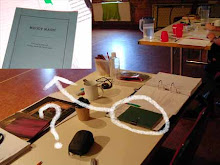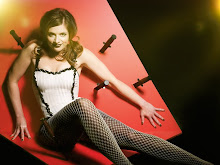
Support for being a Human Spider in the poll is pretty slight, so I've added this picture of one of the greats from old time Vaudeville to inspire you. Looks like a great act! So get on and vote.
Today it's a 'detailing' day. There is a complete schedule of scenes to run for the rest of the rehearsal period pinned up on the door. The scenes they are working on at this stage of the rehearsal are ones that have been causing issues; they're scheduled for further detailed work. To give you a sense of these rehearsals I've recorded a second-by- second breakdown of an hour in the Goodbye Vaudeville Charlie Mudd rehearsal room.
The hour is in the first half of the day. The company has just returned from a morning break, and will be working on a big group scene towards the end of Act I. Half way through this hour Carlee arrives to work on a choreographic scene close to the very beginning of the show;-
0 – 1.06 secs – Chris sets up the scene they will do, quick cast discussion of specifics and where everybody is positioned leading into it.
1.06 – 2.14 Runs the scene
2.14 – 2.45 Stops, discuss details of the final moments.
2.45 – 3.01 Run last bit of scene again.
3.01 - 7.49 Julia asks about technical details relating to the scene. Chris explains how the technical part is going to work. Following the tech explanation, they discuss how the broad pattern of movement works again. Chris works through the stakes of scene, what the important points in the scene are. Then moves to some character details that provide clarity for everybody's roles in this scene. More physical explanation, musical clarification for Mark. About to begin. Wait, another quick question that generates some more clarification for the other characters in the scene.
7.49 - 8.15 Run the last bit of the scene again.
8.15 – 8.38 Chris gives note to Alex about how he's coming in on an important line.
8.38 - 9.22 Runs the last bit again, then moving into the next bit of the scene.
9.22 - 10.35 Chris stops them. Clarity for Jim and Julia of the next bit.
10.35 - 11.29 Runs this bit again. Chris stops it.
11.29 - 12.48 Chris jumps in and clarifies the intention of the scene with Jim, then works in how this effects the other characters again. Actors do a 'dry' line run.
12.48 – 14.44 Run everything they've looked at from the same place again. Pause for a line check, without breaking the scene, begins again. Continues to run further into the scene than previously. Chris freezes the scene, then clarifies what's happening for the other characters in this specific moment. They are about to continue on without breaking...but, another question.
14.44 – 17.33 They break for real this time now, and Chris talks with Jim and Christen about their responses to the situation. There's some discussion about a line that's been proving difficult. Then they're into starting positions again.
17.33 – 17.54 Run from the same place again. Stops.
17.54 – 18.15 Quick vocal detail.
18.15 - 18.46 Run from the same place again. Stops.
18.46 – 19.00 Quick physical detail.
19.00 – 19.18 Run. Stop. Quick line check.
19.18 - 20.24 Run again, this time moving into the next part of the scene. Chris stops it when he's happy they're through that bit.
20.24 - 22.34 Chris clarifies that everything to that point is working. They move on to talk about what happens next in the sequence of scenes. Chris talks to Alex about the detail of the moment to come. Then adds Julia in.
22.34 - 23.34 Run again, starting from an earlier point to get back in.
23.34 – 23.52 Quick detail from Chris; physical and intention of scene.
23.52 - 26.20 Runs again from same spot, (Chris explains FX as they run, real time.) Runs on into the next section. Real time, Chris directs detail, with the scene continuing to run. Scene comes to its end.
26.20 - 27.21 Chris gives it the thumbs up. They're going to run everything they've looked at in the previous half hour. They discuss the set up, precisely which line to run from in the script, where they're positions are.
27.21 – 32.00 They run it all. One clarifying detail, midway, but they stay in it.
32.00 – 34.20 Stops. Chris likes it. Quick question about the overall pitching from Jim. Right? Not right? Chris thinks it's okay. They move onto the dance training. Carlee is here. They set up for the particular scene that Carlee is here to drill. Positions.
34.20 – 36.28 Into the dance sequence. Running it from the top.
36.28 – 37.31 Carlee gives notes. First few steps; good. Identifies problem spot.
37.31 – 37.59 Work through problem spot; slow speed. Stops.
37.59 - 38.42 Begins from the top again, same spot as above. Move by move, half pace. Stop
38.42 – 39.59 Carlee discusses details, and moves to work on the next bit.
39.59 – 40.21 Quick run
40.21 - 40.52 Again. Half time.
40.52 – 41.12 Carlee clarifies details.
41.12 - 41.30 Run.
41.30 – 41.50 Detail.
41.55 - 42.38 Run.
42.38 – 44.21 New bit to look at. Carlee talks the positioning. Discussion of who's looking at who to lead. A discussion of timing of the middle section.
44.21 - 44.56 Run. Carlee demonstrates and yells instructions for steps and timing.
44.56 – 47.58 Back to beginning. Discuss detail. Dry run of timing. More detail of steps and arms. Question to Mark on music at that point. Carlee re-details a previously broadly specified movement.
47.58 - 48.13 Walk it again from that point.
48.13 - 49.16 Quick question. Broad approval. Set up from beginning again.
49.16 - 50.02 Run from top. Carlee dance instructs everything again from out front.
50.02 - 51.30 Discuss positions of the final moment, and actions. They practice it. Then discusses the timing, given the little changes from the re-detailing.
51.30 – 51.40 Run
51.40 – 53.15 Discuss; Carlee wants to re-detail; it's still not quite working. They work through that.
53.15 – 53.39 Run.
53.39 - 55.27 Re-detail again. Something a bit looser; the tight choreography isn't quite right. They discuss that the movement will be driven by an energy now, rather than a tight choreography. Another question about final pose.
55.27 – 56.03 Run
56.03 - 58.49 Carlee is really happy with this final version. Chris wants to clarify the emphasised beats. Carlee asks the cast if they want to go from the top or just the last bit; they want to do the whole thing. Chris wants them to come in from a long way back, so as to cover the transitional space. Carlee and Chris clarify some further details. Chris sets them up for running the scene from the top.
58.49 - 1.08.20 Run from the beginning of the sequence.
1.08.20... ...
That's a typical hour for this time in the process. So many simultaneous questions, thoughts, ideas, stopping, starting, stopping, starting, and sometimes over and over for a single moment.
Tomorrow it's a run first thing - the exact opposite of today. What will it bring?

























